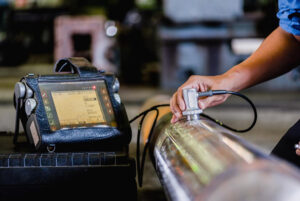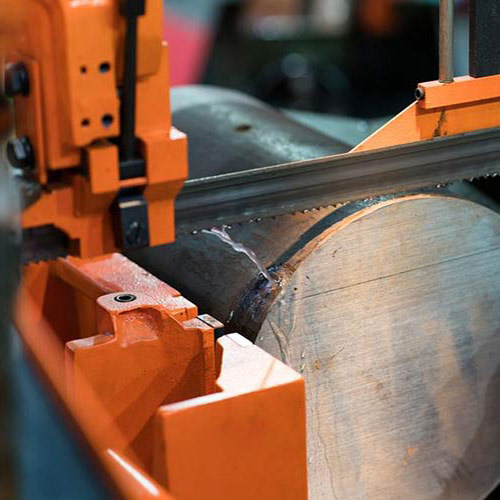Table of Contents
Introduction

The HRC of steel, or Rockwell Hardness C scale, is a fundamental measurement in metallurgy used to determine the hardness of steel materials. It quantifies the resistance of a steel specimen to indentation under a defined load and indenter, providing a numerical value that reflects mechanical strength, wear resistance, and performance under stress. For engineers, material scientists, and quality control professionals, accurately testing the HRC of steel is critical in ensuring component reliability, safety, and longevity.
In this comprehensive guide, we present 4 powerful tips to test HRC of steel. From preparing your sample correctly to selecting the right testing equipment, these techniques will enhance your testing accuracy and repeatability. Whether you work in aerospace, automotive, tooling, or manufacturing industries, mastering HRC testing will help you optimize material selection and guarantee compliance with industry standards.
What Is HRC of Steel?
Before diving into testing methods, it’s essential to clearly define the HRC of steel. The Rockwell Hardness C (HRC) scale measures a material’s resistance to indentation under a specified load and indenter. In this test, a diamond cone indenter applies a minor load (10 kgf) followed by a major load (150 kgf) onto the steel surface. The difference in indentation depth determines the HRC value, which correlates closely with tensile strength, wear resistance, and overall mechanical performance. Common applications of the HRC of steel include assessing tool steels, bearings, gears, and other components where hardness is critical to operational reliability.
Benefits of Knowing the HRC of Steel:
- Informs heat treatment processes and helps optimize hardness profiles
- Predicts wear resistance and service life under load
- Guides material selection for specific industrial applications
Tip 1: Proper Sample Preparation for Accurate HRC of Steel Measurement
Why Sample Preparation Matters in HRC of Steel Testing
Achieving a precise HRC of steel reading begins long before you press the indenter. Sample preparation directly impacts test consistency and reproducibility. Uneven surfaces, residual stresses, or surface coatings can skew hardness results and lead to incorrect assessments.
Steps for Effective Sample Preparation
- Surface Grinding and Polishing: Use progressively finer silicon carbide grit papers down to 1200 grit to remove surface irregularities. Finish with a polishing cloth and diamond suspension for a mirror-like finish.
- Cleaning and Degreasing: After polishing, clean the test area with acetone or isopropyl alcohol to remove contaminants that may affect the indentations.
- Stress Relief: If the steel part has undergone machining or welding, perform a stress relief anneal according to ASTM A247 to minimize residual stresses.
- Flatness Check: Use a surface plate and dial indicator to confirm the test surface is within ±0.005 mm of flatness to ensure accurate indenter seating.
By meticulously preparing your sample, you ensure that the HRC of steel values you record accurately reflect the material’s intrinsic hardness rather than surface artifacts or preparation errors.
Tip 2: Selecting the Right Hardness Tester for Reliable HRC of Steel Data

Comparing Testing Methods for HRC of Steel
Several hardness testing methods exist, but the Rockwell C scale is among the most common for steels due to its simplicity and rapid execution. However, testers vary in automation, load capacity, and indenter type.
- Manual Rockwell Testers: Require operator skill for consistent force application; best suited for low-volume testing.
- Digital Rockwell Testers: Offer automated load control and digital readouts, improving repeatability and data logging.
- Portable Hardness Testers: Useful for field inspections but may sacrifice precision compared to bench-top units.
Key Features to Look For in a Hardness Tester
- Load Accuracy and Stability: Verify the primary (150 kgf) and minor (10 kgf) loads conform to ASTM E18 tolerances.
- Indenter Condition: Confirm the diamond cone indenter is in pristine condition; replace if any wear is visible.
- Machine Calibration: Regularly calibrate your tester using certified reference blocks traceable to national standards.
- Software and Data Management: Choose a tester with integrated software for averaging multiple readings, storing batch data, and generating reports.
Selecting a tester tailored to your production volume and accuracy requirements will significantly improve the reliability of your HRC of steel measurements.
Tip 3: Optimizing Test Parameters for Consistent HRC of Steel Results
Establishing Standard Test Conditions
Uniform test parameters are essential to compare hardness values across batches or suppliers. The primary elements you must control include:
- Test Load: Always use the standard 150 kgf load for HRC of steel unless testing specific alloys requiring different scales.
- Dwell Time: Maintain a consistent dwell time (typically 15 seconds) after applying full test load to allow plastic deformation to stabilize.
- Minimum Number of Indentations: Perform at least five indentations per sample and calculate the average HRC of steel.
Addressing Material Anomalies
- Work Hardening Effects: Polished surfaces may show elevated readings if prior machining induced strain hardening; sample deeper or follow grinding with light etching.
- Microstructural Variations: Coarse-grained or multiphase steels may produce spread in hardness values; use a grid of indentations to map hardness distribution.
By standardizing test parameters and accounting for material-specific traits, you can minimize variability in HRC of steel assessments—crucial for quality control and certification.
Tip 4: Interpreting and Validating HRC of Steel Data Accurately

Statistical Analysis of Hardness Measurements
After collecting HRC of steel readings, statistical evaluation helps you distinguish genuine material properties from outliers caused by testing anomalies or surface inconsistencies. By applying basic statistical tools, you can:
- Mean and Standard Deviation: Calculate the average hardness and measure dispersion. A low standard deviation (e.g., <1 HRC unit) indicates uniformity, while higher values may signal microstructural variations.
- Control Charts: Plot hardness values in X-bar and R charts to monitor trends over production batches. Sudden shifts might reveal equipment drift or material feedstock changes.
- Outlier Identification: Apply Grubbs’ test or Dixon’s Q test to detect and exclude spurious readings. Removing outliers refines your dataset for more accurate reporting.
By incorporating these statistical methods into your quality control workflow, you can proactively identify testing issues and maintain consistent HRC of steel performance across multiple lots.
Correlating Hardness with Mechanical Properties
HRC of steel values often correlate with tensile strength and wear resistance. Use established relationships (e.g., ASTM E18 guidelines) to estimate yield strength:
Estimated tensile strength (MPa) = HRC × 3.45 + 150
Validating hardness data against tensile test results or field performance ensures your HRC of steel measurements translate into real-world reliability.
Mid-Section Table: HRC of Steel vs. Typical Mechanical Properties
| HRC of Steel Value | Approx. Tensile Strength (MPa) | Typical Application |
|---|---|---|
| 30 | 253 | Structural beams, general machining |
| 45 | 303 | Automotive gears, shafts |
| 55 | 343 | High-wear tools, cutting inserts |
| 60 | 363 | Cold-work tooling, bearings |
| 65 | 381 | High-performance bearings, aerospace fittings |
Advanced Considerations for HRC of Steel Testing

While the core methods cover most scenarios, some specialized applications demand deeper insight into high-temperature performance, microstructural layers, and novel testing environments. Below are two advanced techniques to extend your HRC testing capabilities.
High-Temperature Hardness Testing
In industries such as power generation, foundries, and petrochemicals, components often operate at elevated temperatures, making it crucial to assess hardness beyond ambient conditions. To accurately gauge the HRC of steel at temperature:
- Specimen Conditioning: Place test samples in a programmable furnace capable of maintaining temperature tolerance within ±2 °C. Gradually ramp up heating to avoid thermal shock.
- Rapid Transfer Protocol: Utilize specially designed insulated transfer tongs or robotic arms to move specimens from furnace to tester in under 15 seconds, minimizing cooling time.
- In-Situ Testing Adaptations: For critical applications, some bench-top testers offer furnace attachments, allowing indentation at temperature. Ensure the indenter and load mechanisms are rated for high temperatures.
- Temperature Compensation: Apply correction factors per ASTM E18 Annex A. Record ambient laboratory temperature to refine compensation curves and report both compensated and uncompensated HRC values.
- Data Logging and Thermal Profiling: Integrate thermocouples on sample surfaces to log temperature during testing. Correlate hardness values to exact thermal states rather than nominal setpoints.
This approach ensures that your HRC of steel data reflects in-service conditions, aiding in material selection for heat-resilient parts.
Microhardness vs. Macrohardness in HRC of Steel
When dealing with surface-treated components—such as induction-hardened gears, carburized bearings, or thin coatings—macro-scale tests (HRC) may not capture localized hardness gradients. In such cases:
- Selecting Microhardness Scales: Use Vickers (HV) or Knoop (HK) testers with loads ranging from 100 g to 1 kg to produce indents small enough (<50 µm) to assess thin layers without substrate influence.
- Calibration Curve Development: Conduct parallel tests on bulk material samples to generate empirical correlations between microhardness (HV or HK) and HRC of steel. Plot hardness pairs and fit regression curves specific to your alloy system.
- Cross-Sectional Mapping: Prepare metallographic cross-sections and perform a hardness traverse from the surface inward at 0.1–0.5 mm intervals. Translate microhardness results into equivalent HRC values using your calibration curve.
- Layer Thickness Determination: Define the effective depth of hardening by locating the point where microhardness transitions to the base metal value. Express this as a heat-treated case depth alongside HRC metrics.
- Advanced Imaging Integration: Combine hardness mapping with scanning electron microscopy (SEM) to correlate microstructural features—such as martensitic laths or carbide networks—with localized HRC variations.
By blending microhardness and macrohardness techniques, you gain a comprehensive view of surface properties and bulk performance, improving quality control for critical mechanical parts processing applications.
Conclusion
Accurate HRC of steel measurements underpin critical decisions in material selection, heat treatment, and component design. By leveraging these 4 powerful tips to test HRC of steel—meticulous sample preparation, selecting the right tester, optimizing parameters, and thorough data interpretation—you can enhance the reliability and performance of your steel components.
Implement these practices in your quality control workflow to achieve consistent hardness results, minimize production risks, and ensure your products meet the highest industry standards.
FAQ
Q1: What is the difference between HRC and HRB scales?
The HRC scale uses a diamond indenter under a 150 kgf load ideal for harder steels, while HRB uses a 100 kgf load and a hardened steel ball indenter suited for softer materials.
Q2: How often should I calibrate my Rockwell hardness tester?
Calibration should be performed daily using certified reference blocks, and after any maintenance or relocation of the machine.
Q3: Can I use Rockwell testing on coatings or thin layers?
Standard HRC testing may not be accurate on thin coatings; opt for microhardness tests like Knoop or Vickers for layers below 1 mm.
Q4: Why do my HRC of steel results vary across the same sample?
Variations can result from surface preparation differences, microstructural inhomogeneity, or operator inconsistencies—strict standardization helps minimize these effects.
Q5: Is HRC of steel testing destructive?
Rockwell testing is considered minimally destructive, leaving small indentations less than 1 mm in diameter that typically do not affect part performance.
Start applying these powerful tips today to achieve unparalleled accuracy in your HRC of steel testing process!
✨ Let’s Stay Connected!

If you enjoyed this blog on mechanical parts processing, don’t forget to join me on social media for more insights, updates, and community discussions.
📘 Facebook – Connect with me here
Let’s keep exploring, learning, and growing together. Thanks for reading, and see you in the next post! 🚀

